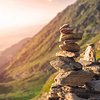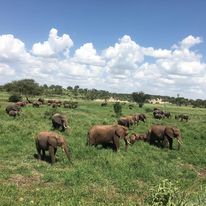Travel Guide To Climb Kilimanjaro
Mount Kilimanjaro, Africa’s highest peak at 5,895 meters (19,341 feet), is a bucket-list destination for many adventurers. Located in Tanzania, the climb offers various routes, such as Marangu, Machame, Lemosho, and Rongai, each providing unique landscapes and challenges. The trek typically takes 5-9 days, depending on the route and acclimatization needs. Climbers pass through diverse ecosystems, from lush rainforests to alpine deserts and glaciers.
We take trekking seriously and carefully select the most experienced mountain guides.We pursue routes and itineraries designed for optimal acclimatization, meaning you have the best chance of a successful summit on a Kilimanjaro trek with Petit Maasai Safaris.
As a professional Climb Kilimanjaro Guide, Petit Maasai Safaris gives priority to your health and safety, especially for high altitudes. We understand the importance of acclimatization and hydration and take necessary precautions to ensure not only your health, but your comfort and ease of mind, too.
More Travel Guide To Climb Kilimanjaro
When To Climb
The best time to climb Mount Kilimanjaro is during the dry season. Read More
Is Climbing Safe?
Only certified mountain guides with wilderness first aid training lead our treks. We are serious about safety and we prioritize good acclimatization for every trek.
What To Pack
And, what you can rent on-location in Tanzania! No need to bring your own tent or trekking poles, we’ve got you covered.
How much does a Kilii Climb cost?
The average Kilimanjaro Climb ranges from $1500 to $5000 or more, depending on factors like group size, route, duration, and services.
Where To Stay
Kilimanjaro is a mesmerizing destination known for its scenic landscapes iconic Mount Kilimanjaro.
Necessary Climbing Equipmentents
Climbing Mount Kilimanjaro is indeed a remarkable adventure, requiring both physical and mental preparation.


Top Tips for a Successful Kilimanjaro Climb
Want to reach the top of Kili? Worried about the success rate of a Kilimanjaro Climb?
To fulfill your dream and have a successful climb on Mount Kilimanjaro, you should:
Prioritize acclimatization. Choose routes with high success rates; such as Lemosho or Machame Routes..
Pay attention to length of the trek. Go with a route that includes an acclimatization day and participate in daily acclimatization hikes, too. Treks that are 7-9 days have a better acclimatization profile than treks that are 5-6 days.
Maintain a steady pace, stay hydrated, and eat well. As we say in Swahili “Haraka Haraka Haina Baraka” (there is no blessing in rushing), it is similar to the idiom; “Slow and steady wins the race”. When it comes to Kilimanjaro, going slowly is often more successful than rushing to the top.
Train beforehand with cardio and strength exercises. Use quality gear for warmth and comfort. Ensure your hiking boots are broken in to avoid blisters.
Kilimanjaro Travel Guide Faqs
What equipment do I need to climb Kilimanjaro?
Essential gear includes sturdy hiking boots, thermal layers, a waterproof jacket, a warm hat, gloves, a sleeping bag, and a daypack. Trekking poles, headlamps, and sunglasses are also recommended. Check out our Packing List and feel free to Contact Us with any specific questions about equipment or gear.
What is the climate of Kilimanjaro?
Trekkers will experience various climates during a Kilimanjaro trek, including:
Rainforest
- Montane Forest
- Moorlands
- Alpine Desert
- Arctic Conditions at the summit
Therefore, you should be pack for all types of weather and temperatures. At the base of Kilimanjaro (often the first day of trekking) it will likely be
around 20-30°C (68-86°F) and you may encounter light showers. As you ascend, temperatures will drop. At higher altitudes, especially at night, it can fall to -7 to -29°C (20 to -20°F), and you may encounter glaciers and snow for the final summit.Be prepared for both warm and freezing conditions.
When is the best time to climb in Tanzania?
The best time to climb Kilimanjaro and Meru is during the dry seasons, either from late June to October or January to March.
For Ol Doinyo Lengai, the dry season is ideal, but the main consideration is a new eruption. The volcano is estimated to erupt every 20-40 years, but the area is under constant rese
Will I have a cell phone signal on the mountain?
There is very limited cell phone coverage on Kilimanjaro. You may get a signal at lower altitudes, but it becomes unreliable higher up. Guides use satellite phones to communicate in case of emergencies.
How fit do I need to be to climb Kilimanjaro?
Mount Kilimanjaro is known as the “most walkable mountain in the world” because of its accessibility. While you do need to be in relatively good physical health, many beginners and elderly climbers have successfully made it to the top by being strategic when planning the route and number of days of their trek.
A Kilimanjaro Climb involves trekking for 4 hours or more, and the final ascent is 5-6 hours of trekking at a high altitude. This requires good cardiovascular health, but this feat is also realized every day by plenty of tourists who would probably not label themselves as athletes, just determined hikers who want to fulfill their dream of reaching the top of Africa’s highest mountain.
What should I pack?
Essential gear includes warm clothing, a good pair of hiking boots, a sleeping bag, and a headlamp. See a more complete packing list here. For Kilimanjaro, altitude sickness prevention is a good idea, talk to your doctor about using Diamox.
Rent Gear in Tanzania
There are arctic conditions atop Mount Kilimanjaro, and it is very cold and windy at the summit of Mt Meru, as well. If you are combining these climbs with a wildlife safari or beach vacation, you may not want to pack a heavy jacket, rain gear or winter hat. Fortunately, you don’t have to! You can rent these items on-location in Tanzania. The gear is in excellent condition and is a great option for first-time climbers who do not want to invest in equipment they may only use once or twice. This is a budget and eco-friendly option
How many hours will I trek each day?
Daily trekking hours vary depending on the route and altitude. Typically, you will hike for 4-7 hours a day, with summit day being the longest, often 10-14 hours of trekking. Adequate rest and acclimatization are essential for a successful climb.
How long does a climb take?
While Kilimanjaro could be climbed in as little as 5 days, we do not suggest this, since it is only advised for experienced climbers with prior altitude acclimatization. We offer Kilimanjaro climbs from 6 – 8 days, on both Machame and Lemosho Routes. Teams interested in an additional acclimatization day can certainly be accommodated, as well. Extra acclimatization will increase your chances of reaching Uhuru Peak.
Mount Meru is a 3 or 4 day climb. We suggest 4 days, as it gives more time for descent and includes a walking safari in Arusha National park at the end of the trek.
Ol Doinyo Lengai is climbed in a single night (10-12 hrs total), but due to the remoteness of the location, it is good to set aside 2 or 3 days and include a visit to stunning Lake Natron and have plenty of rest after climbing all night.
What are the main mountains to climb in Tanzania?
The primary mountains are Mount Kilimanjaro, Mount Meru, and Mount Ol Doinyo Lengai. Kilimanjaro is the highest mountain not only in Tanzania but in all of Africa, standing at 5,895 meters. The second-highest is Meru at 4,566 meters, and Ol Doinyo Lengai at 2,878 meters.
All of these mountains are technically volcanoes:
- Kilimanjaro – an extinct volcano
- Meru – a dormant volcano (last eruption over 100 years ago)
- Ol Doinyo Lengai – an active volcano that saw volcanic activity in 2017.
Do I need technical climbing skills?
For Mount Kilimanjaro and Mount Meru, no technical skills are required, though good physical fitness and preparation for altitude are essential. Be prepared to hike for several hours each day and participate in acclimatization hikes to help adapt to the high elevations.
Mount Ol Doinyo Lengai is very steep, while you don’t need any special gear beyond hiking boots and trekking poles, be prepared to scramble in a few places near the top and be very careful on the steep descent
Can we bring plastic bags to Tanzania?
Tanzania has banned the use of single-use plastic bags to protect the environment. Travelers are advised to avoid carrying plastic bags in their luggage. The exception being for resealable plastic bags used for hygiene items, or plastic compression bags.
We recommend using waterproof bags to hold clothing, especially if trekking during the rainy season. Reusable plastic bags are approved for use in Tanzania
Have questions?
Get in touch!
Experience the epitome of luxury with our tailor-made holidays, crafted exclusively for you. Every detail of your bespoke escape is thoughtfully curated to match your unique preferences. Book your dream getaway today and indulge in unparalleled elegance and comfort.
Our Travellers Reviews
Outstanding tour operator
I can't say enough good things about Bryson and Petit Maasai. Bryson handled our last-minute trip to Tanzania like he'd been working on it for months instead of a handful of days after we connected about a week before our family arrived.Awsome
Exciting trip!!! Bryson made a private tour with masai mbome & we had a rest in mountains near Ngorongoro - everything was awsome!!! Morevover, all of our individual things we re made with great discount!Mike is great ranger too!
Kilimanjaro With Petit Maasai safaris- 5 stars!!!
We book 7 days Kilimanjaro with Petit Maasai safaris after having the safari with another company and we made it with a brilliant guide to the summit. We took the Lemosho route, starting in the rain forest and approached the camp via various tents campsites.
A great experience!
We did a safari in the northern parks of Tanzania with Petit Maasai Safaris and it was a great experience! The guide and the cook were really professional and nice with us, trying to make us feel comfortable and to satisfy our requests. Thanks a lot!
